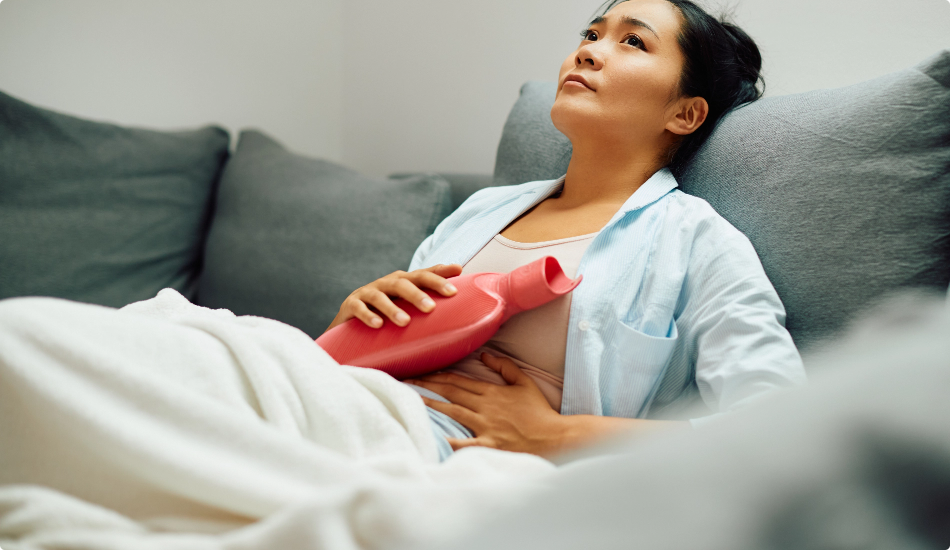
Period pain
It’s normal to have some pain during your period. In fact, period pain affects more than 9 out of 10 women who have periods. Also referred to as ‘dysmenorrhoea’, the experience of period pain varies greatly between women, ranging from mild discomfort in some to severe pain in others. Effective management becomes particularly important if period pain affects your daily life and ability to get through the working day.1-3 Read on to hear about the basics of period pain, including its causes, management advice, and when to consult a doctor.

Understanding period pain
It’s normal to experience some pain during your period. A ‘normal’ experience of period pain usually involves pain on the first 2 days of your period that can be managed with basic self-care measures like pain relief medicines and heat packs, with little or no impact on your daily life.1-3
Causes of period pain
Period pain occurs when the muscles of your uterus tighten or contract. This happens when the body releases natural substances called ‘prostaglandins’, which cause muscle tightening, pain and inflammation. Higher levels of prostaglandins are associated with more severe period pain. This is a normal part of getting your period, and is often referred to as ‘primary dysmenorrhoea’.1-4
Sometimes, period pain may be caused by an underlying health condition like endometriosis (when the tissue from the lining of your uterus grows in other parts of the body) or fibroids (when you have non-cancerous growths in the muscle layer of your uterus). This type of period pain is called ‘secondary dysmenorrhoea’.1-4
Symptoms of period pain
The symptoms of period pain may include:3,4
- Cramping or heaviness in your pelvic area
- Pain in your stomach, that radiates to your lower back and legs
- A dull, constant ache
- Some women also have nausea, diarrhoea, headache and dizziness.
Period pain is a very individual experience and can vary greatly from woman to woman. It can range from mild discomfort in some women, to severe pain in others that impairs their ability to go about their daily life.2
Managing period pain (primary dysmenorrhoea)
Period pain can usually be managed with simple self-care measures, alongside medicines to help relieve pain and inflammation. Ways to manage period pain include:1-3
- Taking pain relief medicines, particularly non-steroidal anti-inflammatory drugs (NSAIDs) like CELEBREX RELIEF® which work to reduce both pain and inflammation5; ask your pharmacist if this product is right for you
- Using a heat pack, hot water bottle, or having a warm bath or shower to help relax your muscles
- Regular, gentle exercise to help release endorphins
- Relaxation techniques like meditation to help lower stress levels
- Complementary therapies like acupuncture, or supplements like fish oil and magnesium
Some contraceptives may also have a positive impact on period pain; talk to your doctor about whether these are appropriate for you.1-3
When to see a doctor
See a doctor if simple treatments for period pain don’t work, or if the pain is so severe that it impacts your quality of life and stops you from going to work. Your doctor may need to investigate the possibility of ‘secondary dysmenorrhoea’, which is period pain caused by an underlying health condition.
It’s often helpful to record information about your period to discuss with your doctor, for example: when you get your period, how long it lasts, how heavy it is, and how the pain affects you.1-3
Related Articles

Back pain is a common condition, with back problems affecting around 1 in 6 Australians.

Shoulder pain can result from injuries, overuse, or underlying conditions

An ankle sprain is an injury to the ligaments that support the ankle pain
ASK YOUR PHARMACIST ABOUT THIS PRODUCT. INCORRECT USE COULD BE HARMFUL.
CELEBREX RELIEF® contains celecoxib 200 mg 10 Capsules. Indications: For the short-term treatment of acute pain in adults with musculoskeletal and/or soft tissue injury, and primary dysmenorrhoea. Recommended dose: A loading dose of 2 capsules on day 1, then 1 capsule once or twice daily, as required for up to 5 days.
References:
1. Healthdirect. Painful periods (dysmenorrhoea). Accessed November 2024. 2. Jean Hailes for Women’s Health. Period pain (dysmenorrhoea). Accessed November 2024. 3. Better Health Channel, Victoria State Government Department of Health. Period pain – dysmenorrhoea. Accessed November 2024. 4. Mayo Clinic. Menstrual cramps. Accessed November 2024. 5. CELEBREX RELIEF® Consumer Medicine Information. 6. Cheung R et al. Clin Ther 2007;29:2498–510. Funded by Pfizer Inc.



